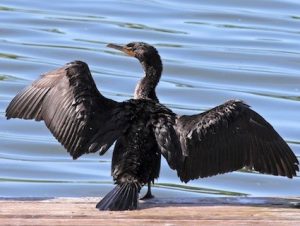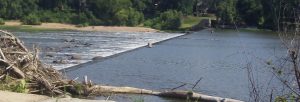A lone cormorant waddled through the towering maze of concrete corridors. He looked a little confused and hungry, maybe a little sad. He reminded me of myself waiting in line for the cook-to-order station at dhall. He had come to the fish ladder adjacent to Bosher dam, probably with the intention of getting a delicious fish snack. Although fish ladders were designed to facilitate the safe passage of fish through dams, studies have concluded that predators congregate where fish are forced to concentrate in traveling through the narrow fish ladder. This phenomenon is referred to as a “predator hotspot,” and the lovely cormorant was hoping to take advantage of the fish buffet he hoped to find (Agostinho et al, 2012).
Unfortunately for the cormorant, the Bosher dam’s fish ladder is only open at certain times of the year to accommodate seasonal fish migrations, and at the time of our paddle, it was not in use. Though the cormorant would eventually leave on an empty stomach, perhaps he was able to enjoy the views from Bosher dam, just as we were able to.
Taking in the scene was beautiful. Downstream, the setting sun painted vibrant hues across the still water. Above the dam, the water swelled up and pooled along the ancient mansions at its banks. Despite the thunderous crash of the spilling water as it raced over the concrete wall of the dam, the entire world felt still for our moment looking at the James. While it provides a scenic spot to rest after some hardcore paddling, the 12 feet high Bosher dam is not in use today. So why is it still in place?
The answer can be seen from the dam. Upstream of the dam where the grand houses sit, wealthy and influential people live along the James and enjoy a good boat ride. They enjoy boating so much that they rallied to protect the Bosher dam and keep it in place because the dam helps pool the water upstream creating a beautiful boating oasis. However, keeping the Bosher dam inhibits many fish species from traveling upstream up to Lynchburg. Though the fish ladder is in place, it is not very effective. The fish ladder is only seasonally operating and often contains predators waiting for meals (like our friend the cormorant). Some fish populations do not use the fish ladder at all. Fish and fishermen alike could benefit from the removal of the Bosher dam.
Souce:
Agostinho, Angelo Antonio, Agostinho, Carlos Sergio, Pelicice, Fernando Mayer, & Marques, Elineide Eugênio. (2012). Fish ladders: safe fish passage or hotspot for predation?. Neotropical Ichthyology, 10(4), 687-696. https://dx.doi.org/10.1590/S1679-62252012000400001


